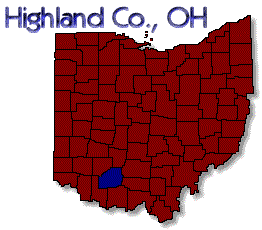

HIGHLAND
COUNTY
HISTORICAL
PLACES
BOYD CEMETERY
The Boyd Cemetery overlooking the site of Barret's mills, was used when the Boyd family were operating the mills and lived in a home on the south bank of Rocy Fork Creek. Dr. John Boyd, one of the first physicians and surgeons to practice in Hillsboro, moved to the farm soon after the birth of a son, J. Milton Boyd, in 1817. Dr. Boyd's wife, Sally (Pierce) Boyd, s{\rtf1\ansi\ansicpg1252\deff0\deflang1033{\fonttbl{\f0\froman\fcharset0 Times New Roman;}} {\colortbl ;\red0\green0\blue0;} \viewkind4\uc1\pard\qc\b\f0\fs20 OTHER and SHOPS AND BUSINESS HOUSES \par \par \pard\cf1\b0\fs24\par George M. Belleson started a blacksmith shop in Sinking Spring in 1856. James C. Bellson took over his fathers shop when he was no longer able to operate it. James and his wife, Roberta, were the parents of Cecil C. born Oct. 16, 1901. He was in the lumber business in the village for fifty years, succeded by his son, T.J. Bellson who is still actively as a lumber man. E. Zuck was a contractor and the builder in the village the mountains some Civil war. Thomas H. McClure carried builder supplies and lumber the does Bellsons opened their business. \par \par R J. McKay was a blacksmith, carriage and wagon manufactureer, soon the Civil War. His back trade was located on the northwest corner of North Main streets, in the northern section of town, William Overshultz and ??? Setty had gained blacksmith's shop but shoed horses in the building now Water street during the turn-of-the-century. W. D. Waddell and Samuel Seltzer operated a shop at the time on Main Street. \par \par They also repaired awakens and carriages, handle all types of and farm implements and fencing. by 1912, Daniel Setty and Samuel Treber were the blacksmiths. To the Thomas C. Weaver who was repairing awakens and carriages and continued until the start WW I. \par \par Finley Black access to save arrived in the in the village of sinking Spring before 1856. When civil war started, he enlisted as a member of the company one 24th Regiment,. When the conflict was over, he returned to the town to open in photographic studio. He made portraits, as well as pictures of the scenic countryside. \par \par Reverend Adison Hite who was among the early tradesmen who kept the settlers supplied with made-to-order shoes. He was also a minister who lived on the eastern border of the village. Hite's competitor was F. F. Huggins, who had a shoe factory and made saddles. \par \par One of the first buildings erected after the village was laid out, was a long, long structure, used to house overnight guest. Later in a much larger building was constructed on the west side of Main Street, between Water and Grand. According to a news item in the in the the export Spring column out of the Highland news for compare Augus him t 10 and , 1876; "Rev. McSurely and family of Hills to boro, are guests at to our popular Hotel, the "Home," and "Messrs. Hiestand, and McKeehan with families, from Hillsboro are also here on sojoun!" \par \par By 1890, M. Rucker of Virginia had taken over the hotel and it was known as "Rucker House." His advertisements stated that, "The way worn traveler finds Rucker House an ideal stopping place, whose homelike comforts appeal to the inmost man." He dispensed Southern hospitality and good food to all guests. If they wanted to hire a "plain or fancy rig" for a trip to the cave region or other places of interest, he could also provide the guest with any varieties, from a well-equipped stable. By 1912, Oscar Eylar was the proprietor of the "Eylar Hotel" which was equipped with a new delivery and feed stable.\par \par \par Daniel Amen establish his small mill on brush Creek in 1810. The same year, said: there would not establish a similar Mail on Baker's board, a short distance from the spring. In 18 days six, Ellen ~ board took over the mail that had been abandoned for some time. He rebuilt to the grist mill, added new and his business flourished for a number of years. But he ship Laura in grain to eastern markets and to in New Orleans. In 1870, a flood washed the dam downstream in the mill was never rebuilt. \par \par But Countrymen family established the watermill on the East Fork of Brush Creek, as early 1803 . George Stillion served as a private bank company B, 175th regiment. , O.V.I., during the Civil War. After they took over the accounting and mill, which changed owners several times in previous years. Roby became the sole proprietor about 1876 and for the next 18 years operated under the name "Cedar Mills ".\par \par Joshua Porter, a native of Marylan., settled in the township as early as 1806. He erected an early sawmill, a mile north of what became Roby's Mill. In 1824, he sold out l to Peter Crum.. After the Civil war. S.T. and F.M. Porter .sons of Joshua Porter, son of the Pioneer Joshua Porter, reestablished the Porter sawmill and began operation of the "Cliff mills. " \par } uccumbed in the summer of 1831, one of the first cholera victims in the area. (6)